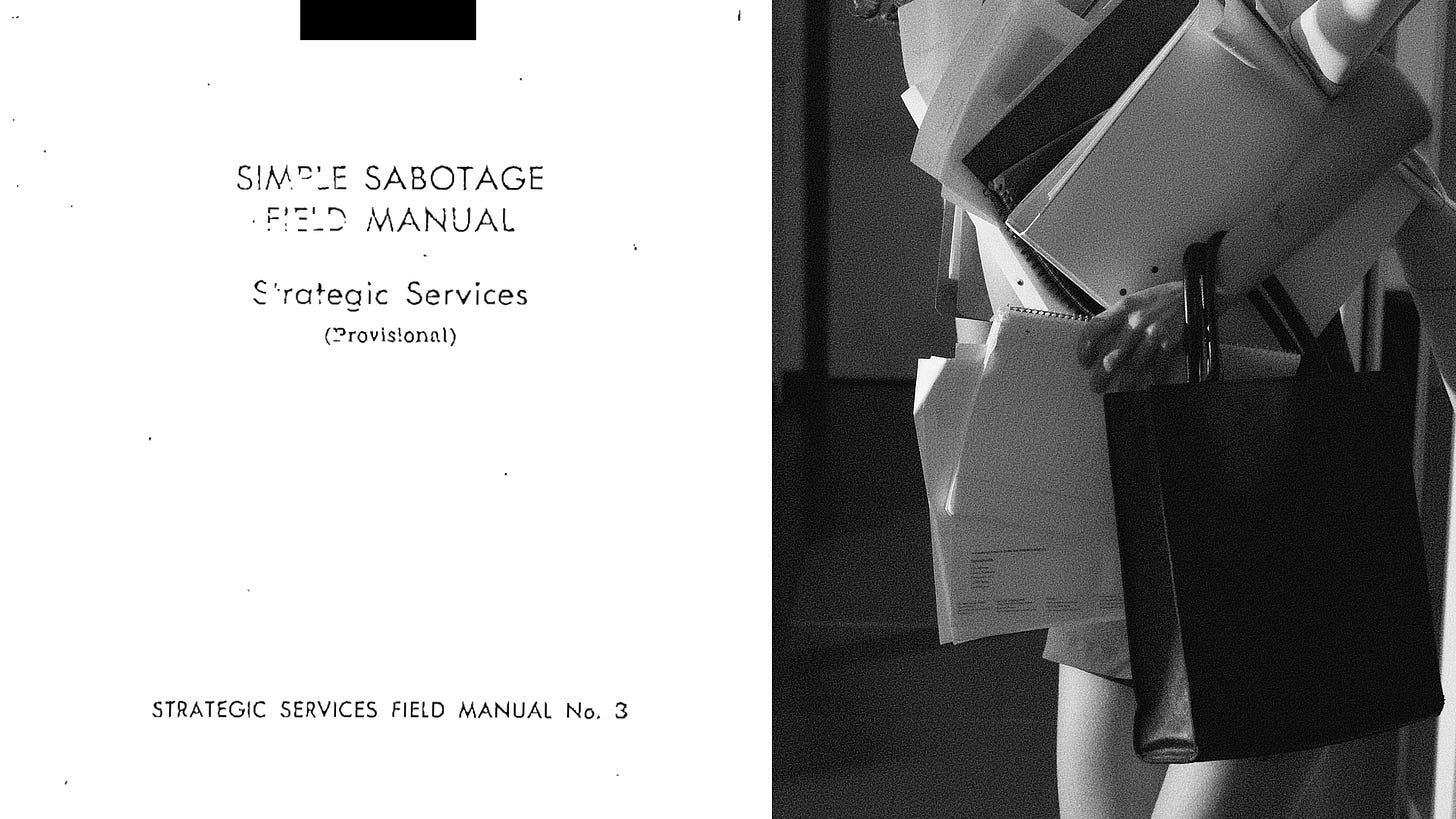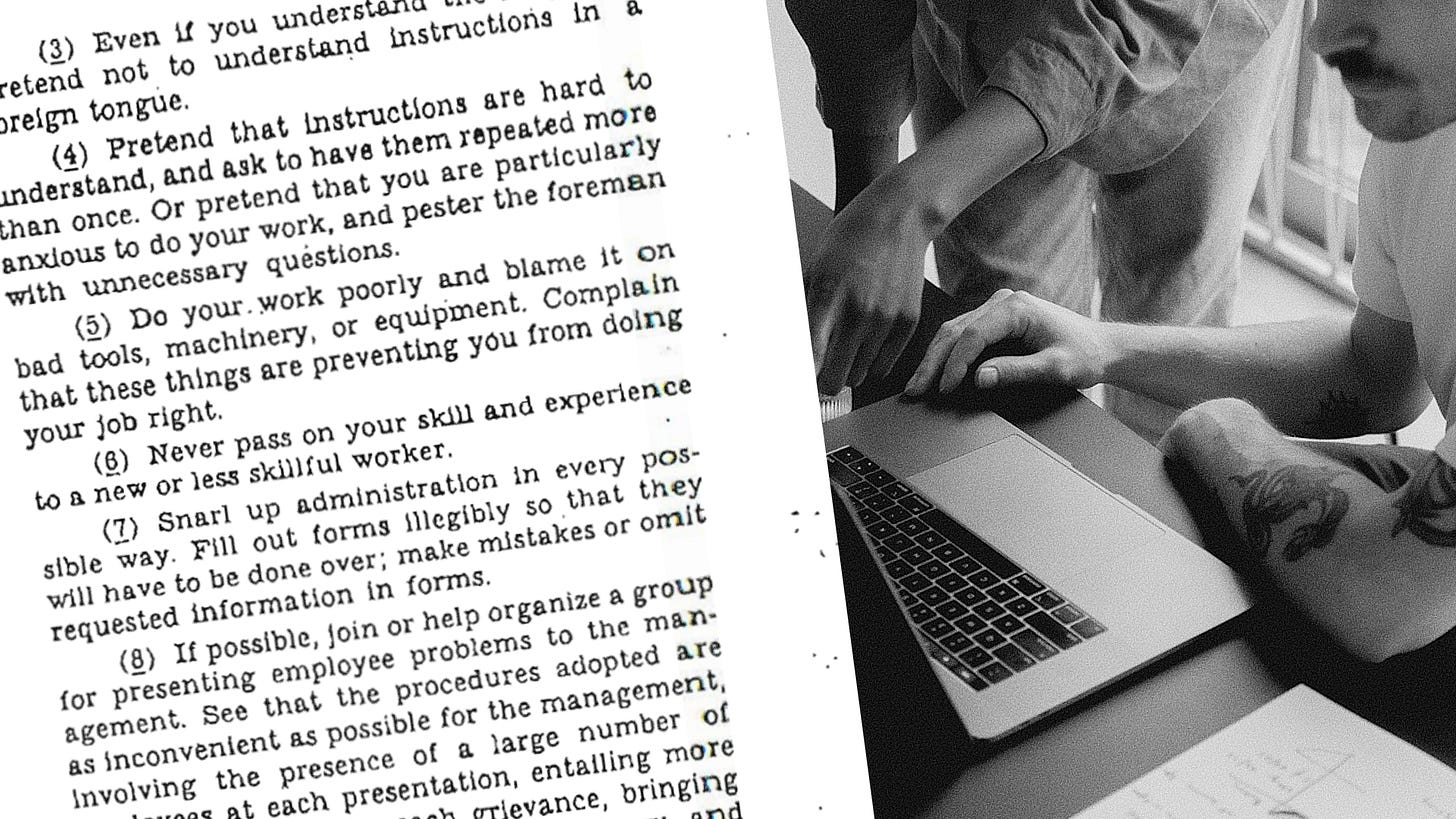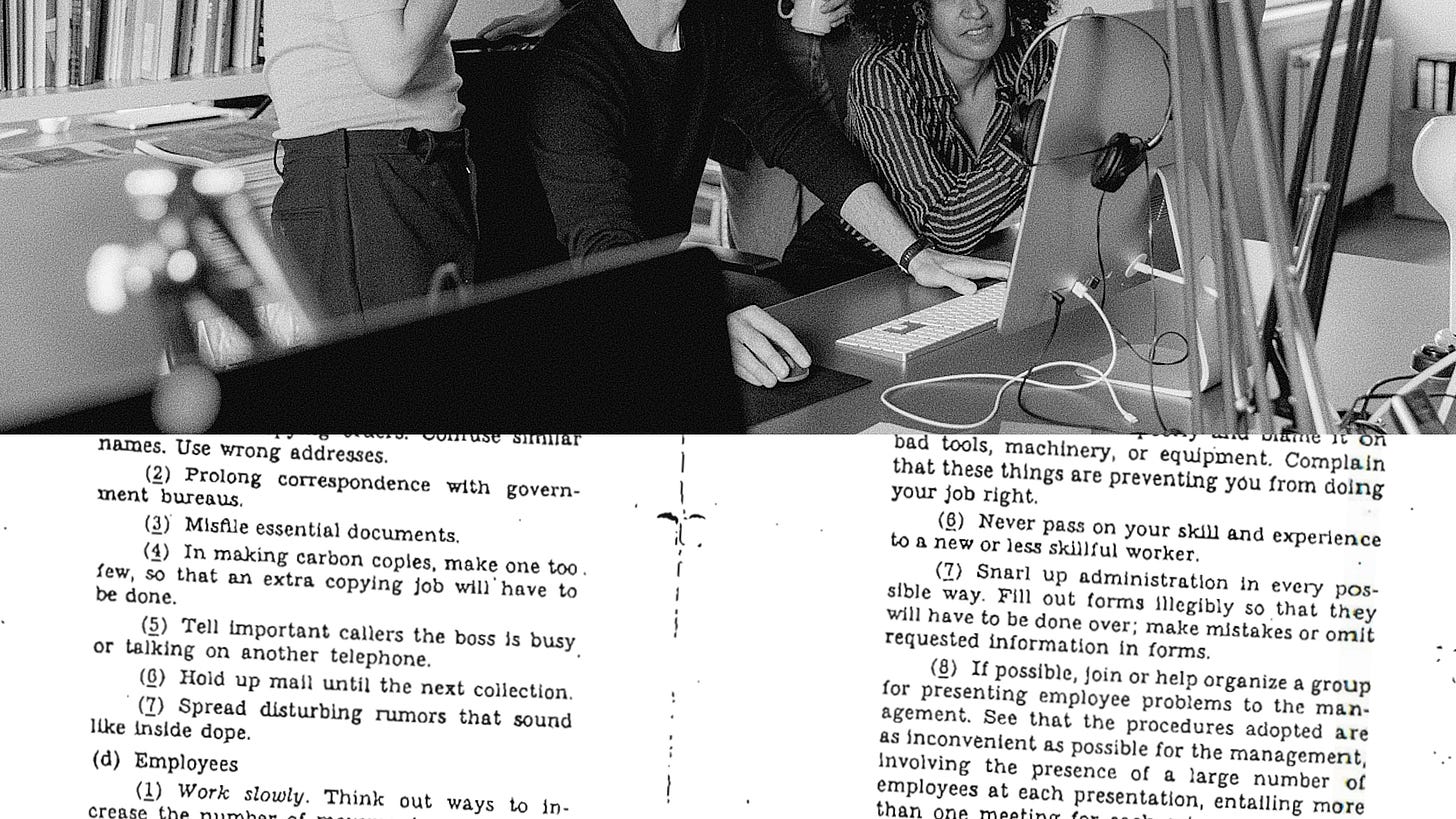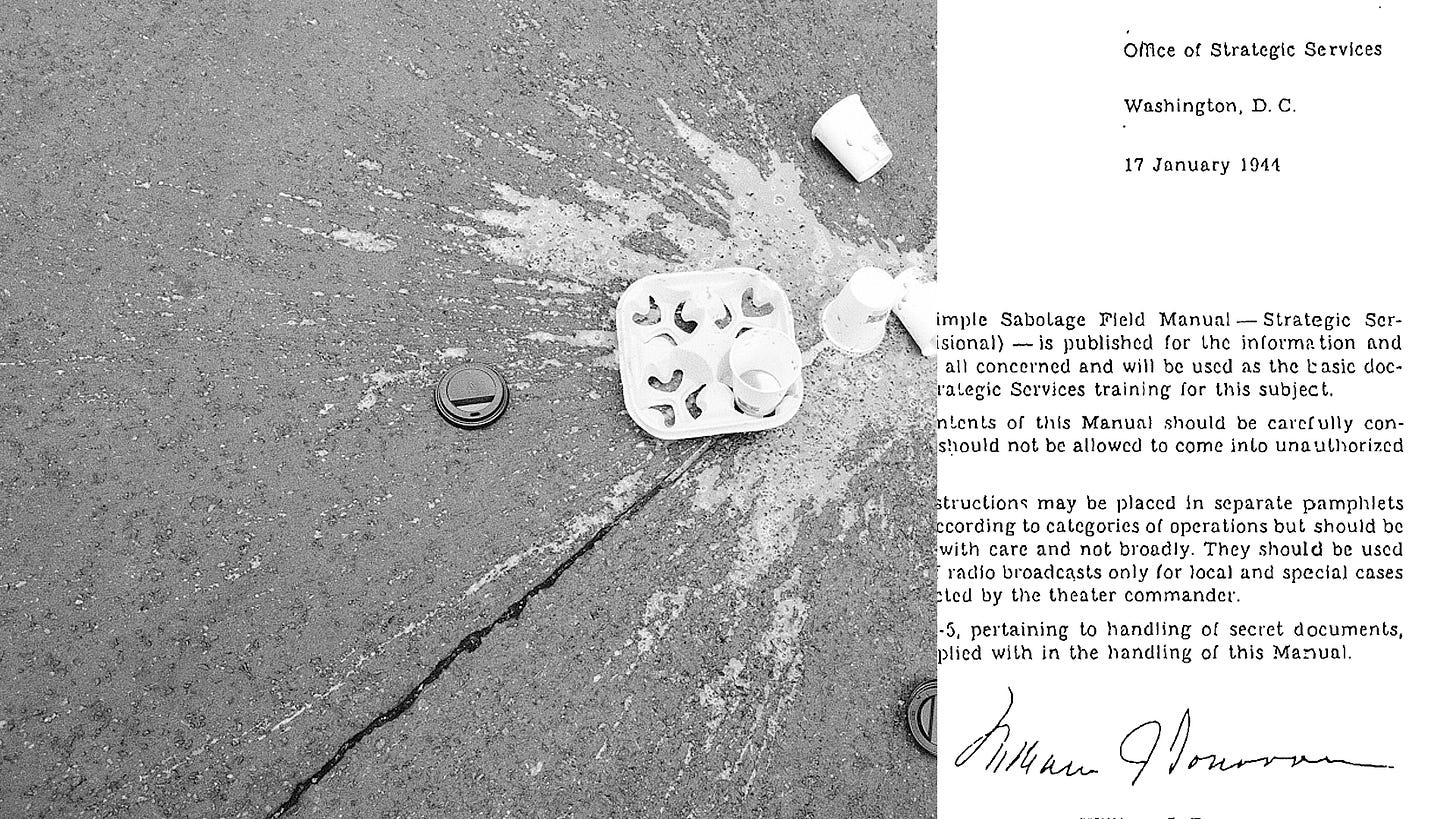Self-Sabotaging Innovation: The Art of Doing Dumb Shit
Breaking free of passivity, apathy, and corporate FOMO
The following piece is a collaboration between Matt Klein + Elisabeth Bromberg.
Elisabeth Bromberg is a brand and creative strategist with 15+ years of experience distilling consumer and cultural insights into actionable strategies. She has worked with Publicis, VaynerMedia, Lippe Taylor, and Weber Shandwick, and brand-side at L'Oreal, T-Mobile, and Estee Lauder Companies. She currently leads Global Content Strategy for a global beauty brand, and is the Founder and Chief Strategy Officer of Mildred Mae, her own empathy-driven brand consultancy.
In 1944, the CIA’s predecessor, the Office of Strategic Services (OSS), published the Simple Sabotage Field Manual — a handbook designed to help ordinary citizens disrupt enemy operations through acts of sabotage.
It was declassified in 2008.
While the manual highlights how to sabotage sewage systems and cause gas explosions – yeah, wild – a large part of the manual pertains to “General Interference with Organizations and Production.”
Or simply: How to sabotage a workplace.
To add to the concern around the government’s published insight around fuel types and gas lines... fast forward 80 years and it’s as if today’s organizations have interpreted this guide’s section on corporate sabotage as a how-to manual for success.
Beginning on Page 28 of Simple Sabotage:
“Insist on doing everything through 'channels.' Never permit shortcuts to be taken in order to expedite decisions...”
“Make 'speeches.' Talk as frequently as possible and at great length...”
“Refer all matters to committees for further study and consideration...”
“Attempt to make the committees as large as possible - never less than five...”
“Haggle over precise wordings of communications...”
“Refer back to matters decided upon at the last meeting...”
“Advocate ‘caution’ and urge your fellow-conferees to be ‘reasonable’ and avoid haste...”
“Insist on perfect work in relatively unimportant products...”
“To lower morale, and with it production, be pleasant to inefficient workers; give them undeserved promotions...”
“Demand written orders...”
“Ask endless questions...”
“See that three people have to approve everything where one would do...”
...Oops
Today, we’re not just creatively stunted, inefficient and unsatisfied...
We’re actively sabotaging ourselves.
And worse, we’re calling it business as usual.
Without reflecting upon such parallels, it’s hard to accept that we’ve adopted self-destructive norms.
And ironically, when you do question these norms, you’re the “saboteur.”
Earlier this year in SOCIAL_Commentary, critical analyses of our memes, ZINE surfaced a viral tweet calling out the absurdity of a fruit’s YouTube channel:
“For anyone curious — because you should be — I tracked it down, and the fruit company’s last YouTube video was uploaded a year ago: “Sour Green Apple Smoothie” (0:39) and viewed < 360 times.”
This begs the question:
“How much of our work exists because we ‘think’ we have to do it?
Arbitrary conditions hypnotize us into believing content for our pears is worth the investment.”
The Psychology of Self-Sabotage
The prerequisite to un-fucking ourselves is to simply become aware of the cognitive biases in place, working against us, slowing us down, and diluting innovation. Once aware, only then can we work against them.
Behavioral psychology offers us insight for starters:
01. Fear of Being Wrong: Our decisions are often driven by Loss Aversion – the cognitive bias that makes us more afraid of failure than excited by potential success. In a world where a single misstep can get us “bollocked,’ we stick with what feels safe, even when it’s clearly not working.
02. The Comfort of Complexity: Complexity Bias convinces us that if something isn’t complicated, it can’t possibly be valuable. We give undue weight to complexity because complexity feels like the “smarter” choice... even when the simpler solution would be more effective.
03. Herd Mentality: Social Proof, identified by Dr. Robert Cialdini, describes how we tend to follow the behaviors of others to validate our actions. It’s easier to copy what everyone else, or especially whatever the loudest “leader” is doing rather than to interrogate and think independently.
04. The Illusion of Progress: Action Bias leads us to believe that doing something – anything – is better than doing nothing, even when the action doesn’t actually move us forward. We equate busyness with productivity, mistaking motion for progress, and perceive novelty as innately valuable.
05. The Confidence of Ignorance: Leaders often overestimate their understanding of specialized knowledge or skills. The Dunning-Kruger Effect causes us to feel most confident when we know the least. This leads to decisions based on perceived competence rather than legitimate expertise.
The brain doesn’t exist to help us think.
It exists to save resources, helping us to not think.
Our cognitive biases and heuristics are not the problem.
Our lack of mindfulness to recognize and overcome them is our problem.
“What’s Inspiring You?”
Being unable to work past these biases contribute to banal work.
What’s the most exciting brand innovation, campaign or community collaboration you’ve seen in the last year?"
This question should not feel so hard to answer.
When asked to conjure our favorite socially progressive brands challenging the status quo in culture, we often hear: Patagonia, TOMS, Dove, Fenty Beauty, REI or Ben & Jerry’s.
Are we not tired of talking about the same names for over a decade?
Meanwhile, survey the “innovation” discourse:
Long Island Iced Tea Corp. rebranded to Long Blockchain Corp. to triple its stock and then got delisted, the $280 Oral-B iO uses AI to provide real-time brushing feedback (in case you forgot how), there was a $46,000,000,000 loss on the metaverse bet, Web3 VC investments cratered -74% since its peak in 2021 (from $33,000,000,000), and as of 2023, 95% of NFTs were considered “dead.”
What’s most sinister is that these corporate decisions and investments are not as much a result of blinded active persistence, but are driven by quiet passive apathy.
We do things not because they work, but because everyone else is doing “it.”
And when everyone else is doing “it,” those decisions evolve into "best practices."
But!
Frequency ≠ Norm ≠ Success
In fact, it’s likely the opposite:
Infrequency ≈ Abnormal ≈ Success
Corporate FOMO contributes to the trite.
So, what’s the JOMO (Joy of Missing Out) in business?
Metrics Are Poisoning You
This isn’t just about bad ideas, poor execution and apathy — it’s about the broader culture we’ve created around innovation. It’s become too hard to stop, reflect, interrogate and interject with fresh ideas, while KPIs run the show.
We’re not solving real problems; we’re searching for validation.
As marketer and author Rory Sutherland puts it, many of the problems we face today are open ended. Yet we aren’t actually looking to solve these problems.
Instead, we’re looking to win arguments. Or as I put it, we’re looking to maintain our employer’s health insurance. Don’t rock the boat.
As a result, we treat open ended problems as if the single answer exists.
And the “best answers” are unfortunately those with the most examples and data.
That’s how the cycle repeats itself. Hype begets hype.
Hop on and contribute to the mound of “evidence” that the metaverse is the future, only to more easily convince the next organization that they too need a Chief Metaverse Officer.
We’ve sacrificed nuanced judgment for a trend report without a methodology.
We’ve sacrificed white space thinking for whatever the average is doing.
And we’ve sacrificed the attributes we care most about (resonance, loyalty, fandom, influence and impact) for the metrics easily available to us (clicks, views and follows).
As Rick Rubin puts it,
“If you can quantify it, it’s not sacred.”
In a moment when everyone is terrified of deviating from the norm or data point, that’s the exact moment to question, dissent and zag.
That’s how you innovate.
How to Dissent
Simply, we need to ask three questions:
Why are we doing this?
Who is this for?
Does this matter to them?
Too often, our drive for innovation is hollow — it’s about ticking boxes, posturing to an industry, and not being left behind.
This has nothing to do with delivering value to the people we care most about and who care most about us.
Progress isn’t driven by more layers of tech, processes, or theory. It’s driven by poking holes, holding a clear mission with guiding values, and creating incentives to diverge.
To sabotage the mindless saboteurs who are following the CIA’s manual, here are some new instructions:
01. ELI5 (Explain Like I’m Five): Play dumb. Require over-simplification in the recommendation. Request or provide a super basic answer to help strip jargon and complexity. If it doesn’t make sense to a five year old, it won’t ever make sense. Make them realize they don’t make sense.
02. Realize Work Fills the Time: Give yourself two weeks and it will always take two weeks. Give yourself two days and it will take two days. If the Ancient Romans could decide the fate of empires in meetings which lasted no longer than the burning of a candle, surely we can discuss the team’s agenda in under an hour. Purposefully limiting time, curbs over-complexity and bureaucracy.
03. Encourage Dissent Top-Down: Foster an environment where challenging the status quo isn't just accepted, it's expected. The resident devil's advocate shouldn’t be an individual, but the shared mindset to sniff out the BS... without antagonism, and with adoration for reality. Get buy-in 1:1, then address the group as a whole once all are on-board.
04. Get Real: Ask yourself, “Do I believe in the shit I’m selling?” If not, get back to work until you do. We spend too much time pretending to care. We have to attempt to answer one of the most difficult questions, “Why is what you do important?” Let’s either work to find that answer, or work to change the output until that answer becomes clear.
05. Work Outside the Org: Challenging status-quo-ism is harder inside the organization. But that doesn’t preclude us from attempting to challenge outside the organization — affecting the larger climate of the system. This makes change internally easier down the line. (ZINE is one attempt...)
Seek New Boxes
Breaking out of this cycle of self-sabotage isn’t easy. It requires a shift in one’s outlook — one which values simplicity over complexity, reflection over reaction, and real progress over the illusion of cool. It requires the cliché of all clichés: bravery. And it requires internal trust to dissent with confidence and limited negative consequences as we experiment.
When curiosity is at tension with productivity, and play is eclipsed by monetization, we get nothing good.
As Rory Sutherland sees it,
“People effectively are laser focused on the things they can get bollocked for. And it's much, much easier to get bollocked for being illogical than it is to get bollocked for being unimaginative.
You can't bollock someone for being unimaginative, but you can bollock someone for being illegal, illogical, or whatever.
And because a large part of our motivation is the avoidance of getting bollocked, we go, well, look, the safe career path is just to tick boxes.
And it's not to look for extra boxes to tick.”
We desperately need extra boxes. That’s what we’re ultimately after.
If we don’t seek new boxes to tick, we’re not innovating — we’re just keeping ourselves busy. And busyness without purpose is the worst form of self-sabotage.










